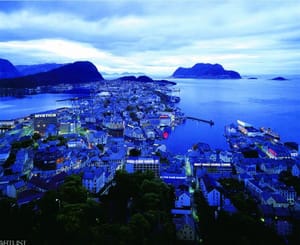- First Name
- Štěpánka
- Surname
- Šimlová
- Born
- 1966
- Birth place
- Plzeň
- Place of work
- Praze
- Website
- http://stepanka-simlova.com
- i-datum
- ↳ Find in the VVP AVU database
- Keywords
- CSU Library
- ↳ Find in the catalogue
About artist
The work of Štěpánka Šimlová oscillates between the utilisation of new media and occasional returns to the handmade artefact and authorial gesture. As far back as the nineties the artist was availing herself of the possibility of manipulating digital images. This manipulation resulted in a certain obscuring or questioning of the classical perpsectivised space. The space of the artist’s Landscapes (1999) is comprised of individual cells or sites. We encounter a tension between the concept of space (magnitude, res extensa) and place. In modern classical discourse space was taken to be an endless geometric or perspectival continuum (by Descartes and Newton). Spatial qualities were the same in all points of the geometrical network; space could be conceptually modelled. This concept only changes at the start of the modern period in subjective and romantic philosophy. Kant comes up with the concept of place, claiming that we are always somehow oriented in space, space is hierarchical and qualitatively diversified. We live in the space of ourselves but always in our personal subjective and concrete place. Place has meaning only if it is occupied by a subject who determines the spatial and perspectival axes (something is above, something below, to the left, to the right, etc.). However, Kant did not give consideration to the physical subject, but understood it as a certain geometrical or psychical point. Place oriented on the physical subject only appears in phenomenological or existential philosophy. Here, space is not a kind of ideal continuum, but the sequence of concrete places which can be occupied. In the modern period the concept appears of subjective or relative space (even physical theories believe that space is not defined by straight lines but oriented vectors, which have their concrete trajectories – Minkowski or Mach). Šimlová identifies with this concept of space. The utilisation of individualised places can be understood as an alternative to the anonymity and artificiality of the consumer space. The artist attacks market icons and communication in her other works too, in which she replaces one-dimensional commercial messages with emotive or existential statements. This serves to disturb banal and commonplace expectations (e.g. Tokyo, 2000 or I am terribly sorry, 2002). In her digital montages and photographic cycles her utilisation of the element of time is conspicuous. The images are not static, but often comprise a certain ambiguous narrative which is dynamised through the use of various perspectival axes, the alternation of detail and whole, etc. The artist conceived of many of her installations with a particular place in mind in which she sought an unmistakable quality of memory.
- Author of the annotation
- Václav Hájek
CV
2002-2007 Head of the Digital Media Studio, Faculty of Art and Design, J. E. Purkyne University, Ústí nad Labem
1989-1996 Academy of Fine Arts, Prague
1993 Trent University, Nottingham, U.K.
1992 Rijks Akademie von Beldendeen Kunsten, Amsterdam
2001 - finalist of Jindřich Chalupecký Award
Exhibitions
- Solo exhibitions
-
2006
Tisloki, Karlín Studios, Praha
2005
Metropolitan reality, Alšova Jihočeská galerie, České Budějovice společně s Irenou Jůzovou
2004
The Little Prayers, Konzulát České republiky v USA, Los Angeles
Tschechische Doerfer - společný projekt s Achimem Mohne, Goethe Institut v
Praze, ve spolupráci s galerií Futura
2003
Shopping and something, Galerie U Bílého jednorožce, Klatovy
Pár dní, Galerie Raketa, Ústí nad Labem
2002
I am terribly sorry..., Moravská galerie Brno, Pražákův Palac, Brno
Ztracená volání, Galerie SCSU, Bratislava, Slovenska Republika - společně s
Petrou Novakovou
The Stranger, Gallery USF, Bergen, Norsko
2001
Sladké sny za hořkých nocí, Galerie hl. města Prahy, Praha
Místa na konci světa, Cité Internationale des Arts, Paříž, Francie
Krajina, Městské divadlo v Kolíně, v rámci Fotografické festivalu Funkeho Kolín
2000
Jednou se musíš vrátit, Galerie Černý pavouk, Ostrava
Jako sen, Muzeum umění, Ostrava
1998
Síla nehybnosti, Galerie Bunkr, Praha
1997
Den Nezávislosti (s I. Voseckým), Kopecký studio, Praha
1996
Goldfinger (s I. Voseckým), Galerie AVU, Praha
1994
Světlo, slovo, svět (s M. Preslovou), Stop galerie, Plzeň
1989
ZOO, Lehman galerie, Drážďany, Německo
- Group exhibitions not included in ARTLIST.
-
2004
Czech Print, ORF Gallery, Linz, Austria
Eastern Alliance - a project of the magazin Umelec, non-gallery space, Berlin
Certain Traces - Barnsdoll, the municipal gallery, Los Angeles
Dialogue Prague - Los Angeles, Post Gallery, Los Angeles
Dialog Praha - Los Angeles, Sovovy mlýny, Holešovice, Prague
2003
Inout, festival of the electronic picture, Prague, Budapest
In and out, Gallery Metro Alex, Berlin
Retrospektiva, Dum Panu z Kunstatu, Brno
Prague Bienalle, National Gallery in Prague,
The Youngest Art, Veletrzni palac, National Gallery in Prague,
2002
A sacra, UMPRUM Gallery, Prague
Czech and Slovak Photography of 80-ties and 90-ties, Municipal
Politikum, Prague Castle Gallery, Prague
Ostensiv, Barakk Gallery, Berlin, Germany
Ostensiv, Centrum Gallery, Moskow, Russia
The Invitantion to Love, Czech Cultural Centre, Berlin, Germany
Border Life, Halle Gallery Vienna, Municipal Gallery, Graz, Austria
Proben Roomen, Gallery Black Garage, Bergen Norway,
Outside in, Galerie Bunker, Berlin
City of Woman, Municipal Gallery, Lublana, Slovenia
It happened by one night, Municipal Gallery, Pilsen 2001 Bohemian Birds, Dresdener Bank Gallery, Frankfurt, Germany
The New Laboratory, National Gallery in Prague, Veletrzni Palace, Prague
The Babylon Time, G4 Gallery, Cheb
The First and The Last One, Spala's Gallery, Prague
Ostensiv, Galerie B/2, Leipzig, Germany
Well Being, Rudolfovy Lazne, Karlovy Vary
Fotok, MEO-Contemporary Art Collection, Budapest, Hungary
The Finalists of Jindrich Chalupecky Award, National Gallery in Prague, Prague
2000
Alles Bewegung, Galerie Barakk, Berlin, Germany
The Contemporary Past, Aleš South-Bohemian Gallery, Hluboká nad Vltavou
The End of The World?, National Gallery in Prague, Kinsky Palace, Prague
4 Elements, Czech Museum of Fine Arts, Prague
Citylights, art in public space, Prague
Melancholie, Moravian Gallery, Brno
Bohemian Birds - Position of Czech Contemporary Art, Dresden, Germany
1999
Maxisklad, Mánes, Prague
About Love, Richter's Villa, Prague
No Sex until Marriage, St. Gabriel's Church, Smíchov, Prague
The Body as a Confident, Czech Cultural Centre, Berlin, Germany
Blue Fire, Biennial of Young Artists, The Stone Bell House, City Gallery Prague
99 CZ, Exhibition of Czech Art of Instalations, Prague
Illusions and Dreams, NoD Gallery, Prague
... (Three Dots), NoD Gallery, Prague
4 four Days in Motion, International Theatre Festival, Prague-Holešovice
1998
City, Kopecký Studio, Prague
Shape of Painting, House of Art, South-Bohemian Gallery, České Budějovice
1997
Simple Messages, Czech Cultural Centre, Budapest, Hungary
The Body as a Confident, House of Art, Olomouc
1996
Simple Messages, Pleskot's Studios, Prague
Interier vs. Exterier, Soros Centre, Bratislava, Slovakia
Confrontation X, Svárov
The Exhibition of Diploma Work, Wallestein Riding Hall, Prague
1995
Test Run, Mánes, Prague
Hybernatus, Gallery of the Academy of Fine Arts, Prague
The Finalist of SBC European Art, SBC Gallery, London, U.K.
1994
Women Houses, Štenc House, Prague
Budoirs, Gallery of Young Art U Řečických, Prague
New Names, Špála Gallery, Prague
1993
That What Is Left, Štenc House, Prague
Konfrontace 9, Svárov
1992
Woman Houses, PKC Ženské domovy, Prague
The Midsummer Night's Dream, Embassy of Polland, Prague
Open studios, Amsterdam, Holland
1991
Artparty II, Parapleu Gallery, Nijmegen, Holland
1990
Artparty I, Komenium, Praha















